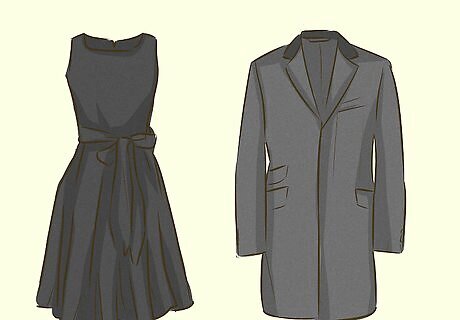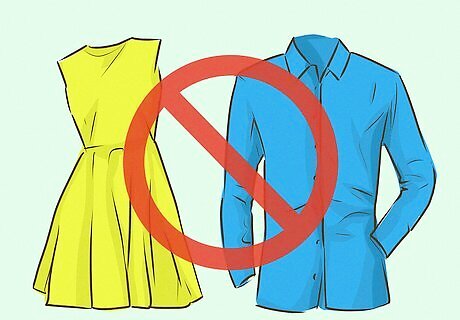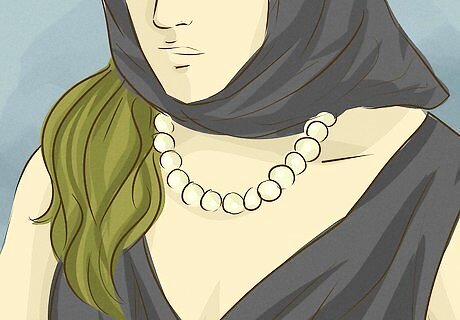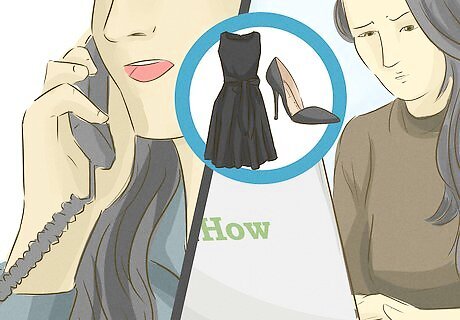
views
Choosing the Right Types of Clothing

Choose black or darker clothing. Traditionally, funeral clothes should be black. However, not everyone adheres strictly to this tradition anymore. It is not uncommon to see people wearing shades like dark gray or navy blue to a funeral. If you choose not to wear black, make sure you select a dark and somber color for your outfit. Stick to dark, solid shades if you don't have any black clothes, or if you just prefer not to wear black. Navy-blues, dark grays, dark greens, and browns are all good shades. However, make sure you get an understanding of the type of funeral before selecting your outfit. For a more traditional funeral, it's advised to err on the side of caution and go for the classic black.

Avoid bright colors. You should never wear bright colors to a funeral. Primary colors like blues, reds, and yellows may come off as offensive or disrespectful. Red, in some cultures, is seen as a sign of celebration. It's particularly important to avoid red. Bright colors should not be part of your outfit at all. A black dress with pink stripes near the bottom, or a black suit over a red button-down shirt, is not appropriate for a funeral. However, in rare cases there is an exception to this rule. Family members, on occasion, may request brighter colors, or a particular color, to honor the deceased. Always go with the family's wishes in this case.

Strive for formality unless otherwise specified. Funerals are usually somber occasions. You want an outfit you might wear to a job interview over an outfit you would wear clubbing. In some cases, the family may request less formal attire to honor the deceased. However, unless other specified, stick with formality. Black, dark gray, or navy suits are a good option. Ties and dress pants should be in similarly dark shades. You can also go with a dark-colored button-down shirt and tie. It's respectful to dress up—avoid wearing anything too casual like shorts or flip-flops, and cover up so you don't show too much skin. Longer dresses and skirts are generally advised for a funeral. Avoid anything too form-fitting, as this may look like a going out outfit rather than a formal one. A dark-colored blouse and dress pants are also a good option.

Be aware of sleeve length. In general, you don't want to show a lot of skin at a funeral. It's best to avoid sleeveless outfits or outfits with very short sleeves. Instead, go for long-sleeved outfits. If you have a sleeveless black dress you want to wear, you can cover up your arms with a shawl or shrug.

Opt for plainer clothes over patterned clothes. Patterns are okay for funerals, as long as they don't look too flashy. A floral patterned skirt, or a dark-colored striped shirt, is played down enough to be appropriate for a funeral. However, bright and flashy patterns are to be avoided, especially if they use flashy colors as well. A black shirt with red polka-dots, for example, is not a great choice for a funeral. As always though, remember to respect the wishes of the deceased's family. In some cases, a particular pattern may be requested.
Selecting Accessories

Pick shoes that are formal, but comfortable. This is especially important if you're going to a wake or burial before or after the funeral. There is a lot of standing and walking at funerals, so your shoes to be comfortable. High heels, for example, are not ideal. Make sure to stick to something formal and dark-colored with your footwear. Black dress shoes or flats are a good option. A nice pair of dark green, navy blue, gray, or black flats or dress shoes are always a great option for a funeral. If it's not a super formal funeral, dark-colored tennis shoes or converse sneakers can also work. Always err on the side of formality, however.

Select a conservative tie. If you're wearing a tie, make sure to play it down. Ties with bright colors or flashy patterns should generally be avoided. A solid-colored tie, or a tie with no pattern, is your best option for a funeral. Make sure to select a darker color, like dark green, navy blue, or gray. However, there are exceptions to this rule. If you have, say, a novelty tie the deceased gave to you, family members may appreciate this gesture. You may want to check ahead of time, just to make sure this won't be taken the wrong way.

Tone down your makeup. If you wear makeup, keep it pretty minimal for a funeral. A funeral is generally a formal occasion. Just as you wouldn't wear dramatic, flashy makeup to your office, do not wear it to a funeral. A light covering of foundation and a nude lipstick is best. Add a small amount of blush, if you want, as well as some very light eye shadow and mascara. As always, there may be exceptions depending on the wishes of family members. If you're, for example, going to the funeral of someone who worked in theater, family members may request flashier, theatrical makeup.

Opt for traditional jewelry. If you're worried about picking the right jewelry, it's appropriate to go without for a funeral. This may help your outfit look more somber. However, if you want to add jewelry, stick to the classics. A string of pearls is vastly more appropriate than a bright, clunky necklace. If you wear earrings, choose respectful ones. Large dangly pieces, or hoop earrings, are a bit too flashy for a funeral. Instead, opt for stud earrings.

Pick appropriate colored pocket squares. If you wear pocket squares with your suits, these should also be dark-colored. Aim for shades like navy blue, dark green, and gray. A pink pocket square is generally inappropriate funeral attire.
Keeping Other Factors in Mind

Take religious beliefs into account. If someone is having a religious ceremony, there may be particular rules regarding dress. Make sure to check the denomination ahead of time and do some quick research. See if there are any rules about attire during mourning. You should always respect the deceased's religion. For example, certain religions may require extreme modesty from women during funeral services. You don't want to show up in a dress or skirt that's too short. An internet search can let you know about religious rituals. However, it's generally better to ask someone from the family. They can give you the best instructions regarding how to dress.

Take different cultural customs into account. If the deceased was from a different cultural background, different colors may be appropriate. While darker colors are traditionally used in Western funerals, this is not always the case in other cultures. Bright colors are associated with mourning in some cultures. In Korea, blue is the color of mourning. In Egypt and Ethiopia, yellow is considered a mourning color. In some Middle Eastern cultures, white is considered a funeral color.

Keep the weather in mind. If there's an outdoor funeral or burial, make sure you consider this. You may have to, say, bring an umbrella if it rains or brings a coat if it's cold out. Make sure these accessories are also funeral appropriate. Even with things like raincoats and umbrellas, remember you're at a funeral. A bright pink umbrella is not generally appropriate for a funeral setting. Black umbrellas, and dark-colored raincoats, are generally the best option. You should also stick to dark-colored coats and jackets. It may be considered bad form to show up for an outdoor burial wearing a white coat.

Follow the deceased's wishes. You should always respect special requests, even when they're unconventional. If the family requests a specific color or pattern for the ceremony, try your best to accommodate this. If a family is going for an untraditional send off to honor the deceased, you should follow their wishes over traditional etiquette.














Comments
0 comment